The autonomic nervous system (ANS) works to keep the body’s homeostasis against internal and external changes in the environment which alter the body’s internal functions (e.g., blood pressure regulation, urinary excretion, water balance, and digestive functions).
Adrenergic agonists are autonomic nervous system drugs that stimulate the adrenergic receptors of the sympathetic nervous system (SNS), either directly (by reacting with receptor sites) or indirectly (by increasing norepinephrine levels). An adrenergic agonist is also called a sympathomimetic because it stimulates the effects of SNS.
Adrenergic agonists are further classified into three: alpha- and beta-adrenergic agonists, alpha-specific adrenergic agonists, and beta-specific adrenergic agonists.
Adrenergic Agonists: Generic and Brand Names
Here is a table of commonly encountered adrenergic agonists, their generic names, and brand names:
- Alpha and Beta Adrenergic Drugs
- dobutamine (Dobutrex)
- dopamine (Intropin)
- ephedrine
- epinephrine (Adrenalin, Sus-Phrine)
- norepinephrine (Levophed)
- Alpha-specific Adrenergic Agonists
- clonidine (Catapres)
- phenylephrine (Neo-synephrine)
- Beta-specific Adrenergic Agonists
- albuterol (Proventil, Ventolin)
- arformoterol (Brovana)
- isoproterenol (Isuprel)
- levalbuterol (Xopenex)
- metaproterenol (Alupent)
- pirbuterol (Maxair Autohaler)
- salmeterol (Serevent Diskus)
- terbutaline (Brethine)
Disease Spotlight: Glaucoma, Shock, and Asthma
- These agents are commonly used for treatment of glaucoma, asthma, and shock or shock-like conditions.
- Glaucoma is an eye condition characterized by increased in intraocular pressure. Alpha adrenergic agonists help dilate the pupils, decrease the secretion of aqueous humor, and increase the uveoscleral outflow. This mechanisms relieve the eyes of too much pressure.
- Shock is a complication most commonly caused by acute blood loss that can significantly alter the functions of the organs and tissues. The effects of these agents to cardiovascular system include pressure increase, vasoconstriction, and increase blood flow to the muscles.
- Asthma is a hypersensitivity reaction to specific triggers characterized by inflammatory reactions and bronchospasm. Beta agonists are usually used for treatment of bronchospasm and other obstructive respiratory conditions.
Alpha- and Beta-Adrenergic Agonists
- Alpha- and beta- agonists are drugs that are generally sympathomimetic. These agonists stimulate all of the adrenergic receptors so they affect both alpha- and beta-receptors.
- Popular examples of drugs under this class include dopamine, dobutamine, and epinephrine.
Therapeutic Action
The desired and beneficial actions of alpha- and beta-agonists are as follows:
- Acting on the adrenergic receptors of the target organs, (i.e., increased heart rate and myocardial contractility with the heart, bronchodilation with lungs, decrease intraocular pressure with eyes).
- Other effects include: sweating, pupil dilation, increase in rate and depth of respirations
- Facilitating the breakdown of glucose stores (glycogenolysis) so it can be used as energy.
Indications
Alpha- and beta-agonists are indicated for the following medical conditions:
- Sympathomimetic of choice for shock is dopamine, a naturally occurring catecholamine. Aside from stimulating the heart to increase the rate and force of its contractions, it also causes dilation of the renal and splanchnic arterioles increasing blood flow to the kidneys. This way, renal shutdown is prevented.
- Dobutamine and ephedrine are synthetic catecholamines indicated for treatment of heart failure. They increase cardiac contractility without causing increase in oxygen demand.
- Ephedrine stimulates release of norepinephrine from nerve endings. Its use is declining because of availability of drugs with more predictable onset and action. Many OTC cold products contain this.
Here are some important aspects to remember for indication of adrenergic agonists in different age groups:
Children
- They are at greater risk for GI and CV complications. Dosage should be exact and should be validated.
- NOTE Phenylephrine is often found in OTC allergy and cold preparations so primary caregivers should be instructed to check labels for ingredients and not combine drugs with similar ingredients.
Adults
- Constant dosage adjustments based on response in patients with shock or shock-like states is needed, especially those on increased risk for cardiac complications.
- Most of these are emergency drugs and can be used in patients who are pregnant and/or lactating. While there are no adequate studies entailing their effects, use of these drugs is justified when benefits clearly outweigh the risks.
Older adults
- Dose adjustment is needed as this age group is also more susceptible to drug side effects.
- They are more likely to have toxic levels of the drug because of renal or hepatic impairments.
- Both adults and older adults must be cautioned against using OTC drugs and complementary therapies.
Pharmacokinetics
Here are the characteristic interactions of alpha- and beta-adrenergic agonists and the body in terms of absorption, distribution, metabolism, and excretion:
| Route | Onset | Peak | Duration |
|---|---|---|---|
| IV | 1-2 min | 10 min | Length of infusion |
Contraindications and Cautions
The following are contraindications and cautions for the use of alpha- and beta-agonists:
- Allergy to any component of the drug. To prevent hypersensitivity reactions.
- Pheochromocytoma. Systemic overload of catecholamines could be fatal.
- Pulmonary hypertension. Exacerbated by the effect of the drug.
- Tachyarrhythmias and ventricular fibrillation. Increased heart rate and oxygen consumption caused by drugs can exacerbate these conditions.
- Hypovolemia. Fluid replacement is the preferred treatment associated with hypotension.
- Halogenated hydrocarbon general anesthetics. This sensitizes the myocardium to catecholamines and could cause serious cardiac effects.
- Peripheral cardiovascular disease. Caution should be used as this can be exacerbated by systemic vasoconstriction effect of the drug.
Adverse Effects
Use of alpha- and beta-agonists may result to these adverse effects:
- Related to sympathetic stimulation: headache, sweating, feelings of tension or anxiety, piloerection
- CV: arrhythmias, hypertension, palpitations, angina, dyspnea
- GI: nausea, vomiting, constipation
- WARNING Because of vasoconstrictive effects, care must be taken to avoid extravasation of any infused drugs. The vasoconstriction in the area of extravasation can lead to necrosis and cell death in that area.
Interactions
The following are drug-drug interactions involved in the use of alpha- and beta-agonists:
- Tricyclic antidepressant (TCA) and monoamine oxidase inhibitors (MAOI). Increased effects of these drugs related to increased norepinephrine levels or increased receptor stimulation that occurs with both drugs. TCAs increase sympathomimetic effects with phenylephrine but decreased antihypertensive effects with clonidine.
- Ma huang, guarana, caffeine. Increased risk of hypertension especially with alpha agonists.
- Propranolol. Paradoxical hypertension with clonidine
- Any other adrenergic antagonist. Loss of effectiveness of drugs.
Nursing Considerations
Here are important nursing considerations when administering alpha- and beta-agonists:
Nursing Assessment
These are the important things the nurse should include in conducting assessment, history taking, and examination:
- Assess for contraindications or cautions (e.g. history of allergy, pheochromocytoma, fatal arrhythmias, etc.) to avoid adverse effects.
- Establish baseline physical assessment to monitor for any potential adverse effects.
- Assess vital signs, especially pulse and blood pressure to monitor for possible excess stimulation of the cardiac system.
- Note respiratory rate and auscultate lungs for adventitious sounds to evaluate effects on bronchi and respirations.
- Monitor urine output to evaluate perfusion of the kidneys and therapeutic effects.
- Monitor laboratory test results (e.g. liver and renal function tests) to determine need for possible dose adjustment, and serum electrolyte levels to evaluate fluid loss and appropriateness of therapy.
Nursing Diagnosis and Care Planning
Here are some of the nursing diagnoses that can be formulated in the use of this drug for therapy:
- Decreased cardiac output related to CV effects
- Ineffective tissue perfusion related to CV effects
Implementation with Rationale
These are vital nursing interventions done in patients who are taking alpha- and beta-agonists:
- Use extreme caution in calculating and preparing doses of these drugs because even small errors could have serious effects.
- Use proper, aseptic technique when administering ophthalmic or nasal agents (alpha- and beta- adrenergic agonists) to prevent injection and assure the therapeutic effectiveness of the drug.
- Monitor patient response closely (vital signs, ECG, urine output) to ensure the most benefit with the least amount of toxicity.
- Maintain phentolamine on standby in case extravasation occurs. Save the area by infiltrating 10 mL of saline containing 5-10 mg of phentolamine.
- Provide comfort measures (e.g. light control, encouragement to void, monitoring bowel functions, support and relaxation measures) to help patient cope with the sympathomimetic effects of the drug.
- Provide patient education about drug effects and warning signs to report.
Evaluation
Here are aspects of care that should be evaluated to determine effectiveness of drug therapy:
- Monitor patient response to therapy (improvement in blood pressure, ocular pressure, bronchial airflow).
- Monitor for adverse effects (e.g. CV changes, decreased urine output, headache, GI upset).
- Evaluate patient understanding on drug therapy by asking patient to name the drug, its indication, and adverse effects to watch for.
- Monitor patient compliance to drug therapy.
Alpha-Specific Adrenergic Agonists
- Alpha-specific adrenergic agonists or alpha-agonists are drugs that bind primarily to alpha-receptors rather than to beta-receptors.
- Popular examples of drugs under this class include clonidine, midodrine, and phenylephrine.
Therapeutic Action
The desired and beneficial action of alpha-agonists is:
- Acting as a powerful postsynaptic alpha-adrenergic receptor stimulant causing vasoconstriction and raising systolic and diastolic blood pressure with little effect on the beta-receptors of the heart.
Indications
Alpha-agonists are indicated for the following medical conditions:
- Phenylephrine is a potent vasoconstrictor and alpha1-agonist with little or no effect on the heart or bronchi and is used in many combination cold and allergy products. Parenterally, it is used in the following medical conditions: shock or shock-like states and paroxysmal supraventricular tachycardia. It is also used to prolong local anesthesia and to maintain blood pressure during spinal anesthesia. Topically, it used for treatment of allergic rhinitis and symptoms of otitis media.
- Midodrine is an oral drugs used to treat orthostatic hypotension in patients who do not respond to traditional therapy. It activates alpha1-adrenergic receptors, leading to peripheral vasoconstriction and an increase in vascular tone and blood pressure.
- Clonidine specifically stimulates alpha2-receptors of the CNS leading to decreased CNS outflow of norepinephrine. Orally and transdermally, it is used to control hypertension and as an injection, it is for epidural infusion for controlling cancer pain.
Pharmacokinetics
Here are the characteristic interactions of alpha-agonists and the body in terms of absorption, distribution, metabolism, and excretion:
| Route | Onset | Peak | Duration |
|---|---|---|---|
| IV | Immediate | – | 15-20 min |
| IM, subcutaneous | 10-15 min | – | 30-120 min |
| Topically | Very little systemic absorption occurs | – | – |
Contraindications and Cautions
The following are contraindications and cautions for the use of alpha-agonists:
- Allergy to any component of the drug. To prevent hypersensitivity reactions.
- Severe hypertension or tachycardia. Possible additive effects.
- Narrow-angle glaucoma. Can be exacerbated by arterial constriction.
- Pregnancy and lactation. No adequate studies on the effects so use is reserved for situations in which the benefit to the mother outweighs any potential risk to the fetus or neonate.
- CV disease and vasospasm. Caution is used because these conditions could be aggravate by the vascular effects of the drug
- Thyrotoxicosis and diabetes. Sympathetic stimulation has thyroid-stimulating and glucose-elevating effects
- Renal or hepatic impairment. Can interfere with metabolism and excretion of the drug.
Adverse Effects
Use of alpha-agonists may result to these adverse effects:
- CNS: anxiety, restlessness, depression, fatigue, strange dreams, personality changes
- Sympathetic stimulation: blurred vision, photosensitivity
- CV: arrhythmias, ECG changes, blood pressure changes, peripheral vascular problem
- GI: nausea, vomiting, anorexia
- GU: decreased urinary output, difficulty urinating, dysuria, changes in sexual function
- WARNING Sudden withdrawal can lead to: tachycardia, hypertension, arrhythmias, flushing, and even death. Taper drugs over 2-4 days.
Interactions
The following are drug-drug interactions involved in the use of alpha-agonists:
- MAOIs: severe hypertension, headache, and hyperpyrexia with phenylephrine
- TCA: increased sympathomimetic effects with phenylephrine; decreased antihypertensive effects with clonidine
- Digoxin, beta-blockers, antipsychotics: increased drug effects with midodrine
- Adrenergic antagonists: loss of effectiveness of adrenergic agonists
Nursing Considerations
Here are important nursing considerations when administering alpha-agonists:
Nursing Assessment
These are the important things the nurse should include in conducting assessment, history taking, and examination:
- Assess for contraindications or cautions (e.g., history of allergy, CV diseases, thyrotoxicosis or diabetes, etc.) to avoid adverse effects.
- Establish baseline physical assessment to monitor for any potential adverse effects.
- Assess level of orientation, affect, reflexes, and vision to monitor for CNS changes related to drug therapy.
- Monitor blood pressure and pulse, assess peripheral perfusion, and obtain electrocardiogram, if indicated, to determine drug effectiveness and evaluate for adverse CV effects.
- Monitor urine output to evaluate perfusion of the kidneys and therapeutic effects.
- Evaluate patient for nausea and constipation to assess adverse effects of the drug and establish appropriate interventions.
- Monitor laboratory test results (e.g., liver and renal function tests) to determine need for possible dose adjustment.
Nursing Diagnosis and Care Planning
Here are some of the nursing diagnoses that can be formulated in the use of this drug for therapy:
- Decreased cardiac output related to blood pressure changes, arrhythmias, or vasoconstriction
- Disturbed sensory perception related to CNS effects
- Risk for injury related to CNS or CV effects
Implementation with Rationale
These are vital nursing interventions done in patients who are taking alpha-agonists:
- Do not discontinue abruptly to prevent rebound hypertension.
- Monitor blood pressure, orthostatic blood pressure, pulse, rhythm, and cardiac output regularly to adjust dose or discontinue the drug of CV effects are severe.
- Maintain phentolamine on standby when administering phenylephrne in case extravasation occurs. Save the area by infiltrating 10 mL of saline containing 5-10 mg of phentolamine within 12 hours after extravasation to preserve tissue.
- Provide comfort measures (e.g., rest and environmental control) to help patient cope with the drug effects.
- Provide patient education about drug effects and warning signs to report to promote understanding and compliance.
Evaluation
Here are aspects of care that should be evaluated to determine effectiveness of drug therapy:
- Monitor patient response to therapy (improvement in condition being treated).
- Monitor for adverse effects (e.g., GI upset, CNS, and CV changes).
- Evaluate patient understanding on drug therapy by asking patient to name the drug, its indication, and adverse effects to watch for.
- Monitor patient compliance to drug therapy.
Beta-Specific Adrenergic Agonists
- Beta-specific adrenergic agonists or beta-agonists are drugs that bind primarily to beta-receptors rather than to alpha-receptors.
- Popular examples of drugs under this class include albuterol, salmeterol, and terbutaline.
Therapeutic Action
The desired and beneficial action of beta-agonists is:
- Acting on beta-adrenergic receptors to produce increased heart rate, positive inotropic effect, bronchodilation, and vasodilation.
Indications
Beta-agonists are indicated for the following medical conditions:
- Treatment of bronchial spasm, asthma, and other obstructive pulmonary conditions.
Pharmacokinetics
Here are the characteristic interactions of beta-agonists and the body in terms of absorption, distribution, metabolism, and excretion:
| Route | Onset | Peak | Duration |
|---|---|---|---|
| IV | Immediate | – | 1-2 min |
| Half-life (T1/2) | Metabolism | Excretion |
|---|---|---|
| Unknown | tissues | – |
Contraindications and Cautions
The following are contraindications and cautions for the use of beta-agonists:
- Allergy to any component of the drug. To prevent hypersensitivity reactions.
- Pulmonary hypertension. Can be exacerbated by drug effects
- Anesthesia with halogenated hydrocarbons. Can sensitize the myocardium to catecholamines and could cause a severe reaction
- Eclampsia, uterine hemorrhage, and intrauterine death. Can be complicated by uterine relaxation or increased blood pressure
- Thyrotoxicosis and diabetes. Sympathetic stimulation has thyroid-stimulating and glucose-elevating effects
- Severe renal impairment. Can alter drug excretion
Adverse Effects
Use of beta-agonists may result to these adverse effects:
- CNS: anxiety, restlessness, fatigue, fear, tremor, headache
- CV: tachycardia, angina, myocardial infarction, palpitations
- Respiratory: difficulty of breathing, bronchospasm, severe pulmonary edema
- GI: nausea, vomiting, anorexia, GI upset
- Others: sweating, pupil dilation, rash, muscle cramps
Interactions
The following are drug-drug interactions involved in the use of beta-agonists:
- Other sympathomimetic drugs: increased sympathomimetic effects
- Beta-blockers: decreased therapeutic effects
Nursing Considerations
Here are important nursing considerations when administering beta-agonists:
Nursing Assessment
These are the important things the nurse should include in conducting assessment, history taking, and examination:
- Assess for contraindications or cautions (e.g., history of allergy, uterine hemorrhage, thyrotoxicosis or diabetes, etc.) to avoid adverse effects.
- Establish baseline physical assessment to monitor for any potential adverse effects.
- Assess CV status (pulse rate and blood pressure) to evaluate for any CV effects associated with SNS stimulation.
- Assess respiratory status to monitor drug effects and assess for respiratory adverse effects.
- Monitor urine output to evaluate perfusion of the kidneys and therapeutic effects.
- Monitor laboratory test results (e.g., liver and renal function tests) to determine need for possible dose adjustment.
Nursing Diagnosis and Care Planning
Here are some of the nursing diagnoses that can be formulated in the use of this drug for therapy:
- Acute pain related to CV and systemic effects
- Decreased cardiac output related to CV effects
- Ineffective tissue perfusion related to CV effects
Implementation with Rationale
These are vital nursing interventions done in patients who are taking beta-agonists:
- Monitor pulse and blood pressure carefully during administration to arrange to discontinue the drug at any sign of toxicity.
- Ensure that a beta-blocker is readily available when giving parenteral isoproterenol in case severe reaction occurs.
- Use minimal doses of isoproterenol needed to achieve desired effects to prevent adverse effects and maintain patient safety.
- Provide comfort measures to help patient cope with the drug effects.
- Provide patient education about drug effects and warning signs to report to promote understanding and compliance.
Evaluation
Here are aspects of care that should be evaluated to determine effectiveness of drug therapy:
- Monitor patient response to therapy (improvement in condition being treated, stabilization of blood pressure, prevention of preterm labor).
- Monitor for adverse effects (e.g., GI upset, respiratory, and CV changes).
- Evaluate patient understanding on drug therapy by asking patient to name the drug, its indication, and adverse effects to watch for.
- Monitor patient compliance to drug therapy.
Recommended Resources
Our recommended nursing pharmacology resources and books:
Disclosure: Included below are affiliate links from Amazon at no additional cost from you. We may earn a small commission from your purchase which will help support us. Thank you! For more information, check out our privacy policy.
Pharm Phlash! Pharmacology Flash Cards #1 BEST SELLER!
Test-yourself review cards put critical clinical information for nearly 400 of the top generic medications at your fingertips. And, you can count on them for accuracy, because each card is based on content from Davis’s Drug Guide for Nurses. Increase your test scores in pharmacology class.
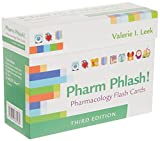
Focus on Pharmacology (8th Edition)
Focus on Nursing Pharmacology makes challenging concepts more approachable. Engaging learning features cultivate your clinical application, critical thinking and patient education capabilities. This updated 8th edition builds on your knowledge of physiology, chemistry and nursing fundamentals to help you conceptualize need-to-know information about each group of drugs.
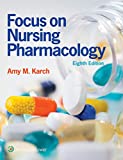
Pharmacology Made Incredibly Easy (Incredibly Easy! Series®)
Nursing pharmacology guide offers step-by-step guidance so you can grasp the fundamentals in enjoyable Incredibly Easy style. This is the perfect supplement to class materials, offering solid preparation for NCLEX® as well as a handy refresher for experienced nurses. Colorfully illustrated chapters offer clear, concise descriptions of crucial nursing pharmacology concepts and procedures.
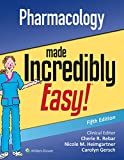
Lehne’s Pharmacology for Nursing Care (11th Edition)
The Eleventh Edition of Lehne’s Pharmacology for Nursing Care provides a thorough understanding of key drugs and their implications for nursing care. This text, written by renowned nursing educators, helps you comprehend and apply pharmacology principles. A clear and engaging writing style simplifies complex concepts, making even the most challenging pharmacology content enjoyable. We recommend this book if you want a comprehensive nursing pharmacology guide.
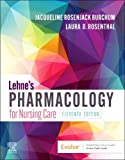
Nursing Drug Handbook
Nursing2023 Drug Handbook delivers evidence-based, nursing-focused drug monographs for nearly 3700 generic, brand-name, and combination drugs. With a tabbed, alphabetical organization and a “New Drugs” section, NDH2023 makes it easy to check drug facts on the spot.
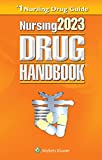
Pharmacology and the Nursing Process
The 10th edition of Pharmacology and the Nursing Process offers practical, user-friendly pharmacology information. The photo atlas contains over 100 unique illustrations and photographs depicting drug administration techniques. Updated drug content reflects the most recent FDA drug approvals, withdrawals, and therapeutic uses.
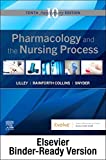
Mosby’s Pharmacology Memory NoteCards: Visual, Mnemonic, and Memory Aids for Nurses
The 6th edition of Mosby’s Pharmacology Memory NoteCards: Visual, Mnemonic, & Memory Aids for Nurses incorporates illustrations and humor to make studying easier and more enjoyable. This unique pharmacology review can be utilized as a spiral-bound notebook or as individual flashcards, making it ideal for mobile study.
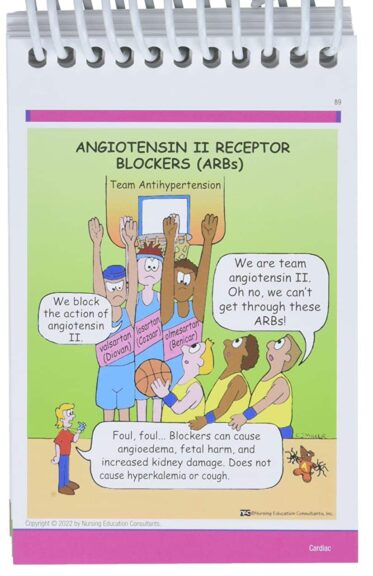
See Also
Here are other nursing pharmacology study guides:
- Nursing Pharmacology – Study Guide for Nurses
Our collection of topics related to nursing pharmacology - Pharmacology Nursing Mnemonics & Tips
These nursing mnemonics aim to simplify the concepts of pharmacology through the use of a simple, concise guide. - Generic Drug Name Stems Cheat Sheet
Learn about these generic drug name stems to help you make sense of drugs easier! - Common Drugs and Their Antidotes
A guide to drug antidotes that nurses should be familiar about. - IV Fluids and Solutions Guide & Cheat Sheet
Get to know the different types of intravenous solutions or IV fluids in this guide and cheat sheet. - Drug Dosage Calculations NCLEX Practice Questions (100+ Items)
Care to take the challenge? This quiz aims to help students and registered nurses alike grasp and master the concepts of medication calculation.
We have a pill for that…
Drug Guides NEW!
Individual drug guides and nursing considerations for the most common medications used in nursing pharmacology:
- Acetaminophen (Tylenol)
- Aspirin
- Atorvastatin (Lipitor)
- Enoxaparin (Lovenox)
- Furosemide (Lasix)
- Gabapentin
- Hydromorphone (Dilaudid)
- Lisinopril
- Metoprolol
- Morphine
Gastrointestinal System Drugs
Respiratory System Drugs
- Antihistamines
- Bronchodilators and Antiasthmatics
- Decongestants
- Expectorants and Mucolytics
- Inhaled Steroids
- Lung Surfactants
Endocrine System Drugs
- Adrenocortical Agents
- Antidiabetic Agents
- Glucose-Elevating Agents
- Hypothalamic Agents
- Insulin
- Parathyroid Agents: Bisphosphonates, Calcitonins
- Pituitary Drugs
- Sulfonylureas
- Thyroid Agents
Autonomic Nervous System Drugs
- Adrenergic Agonists (Sympathomimetics)
- Adrenergic Antagonists (Sympatholytics)
- Anticholinergics (Parasympatholytics)
- Cholinergic Agonists (Parasympathomimetics)
Immune System Drugs
Chemotherapeutic Agents
- Anthelmintics
- Anti-Infective Drugs
- Antibiotics
- Antifungals
- Antineoplastic Agents
- Antiprotozoal Drugs
- Antiviral Drugs
Reproductive System Drugs
Nervous System Drugs
- Antidepressants
- Antiparkinsonism Drugs
- Antiseizure Drugs
- Anxiolytics and Hypnotic Drugs
- General and Local Anesthetics
- Muscle Relaxants
- Narcotics, Narcotic Agonists, and Antimigraine Agents
- Neuromuscular Junction Blocking Agents
- Psychotherapeutic Drugs
Cardiovascular System Drugs
References and Sources
References and sources for this pharmacology guide for Adrenergic agonists:
- Karch, A. M., & Karch. (2011). Focus on nursing pharmacology. Wolters Kluwer Health/Lippincott Williams & Wilkins. [Link]
- Katzung, B. G. (2017). Basic and clinical pharmacology. McGraw-Hill Education.
- Lehne, R. A., Moore, L. A., Crosby, L. J., & Hamilton, D. B. (2004). Pharmacology for nursing care.
- Smeltzer, S. C., & Bare, B. G. (1992). Brunner & Suddarth’s textbook of medical-surgical nursing. Philadelphia: JB Lippincott.
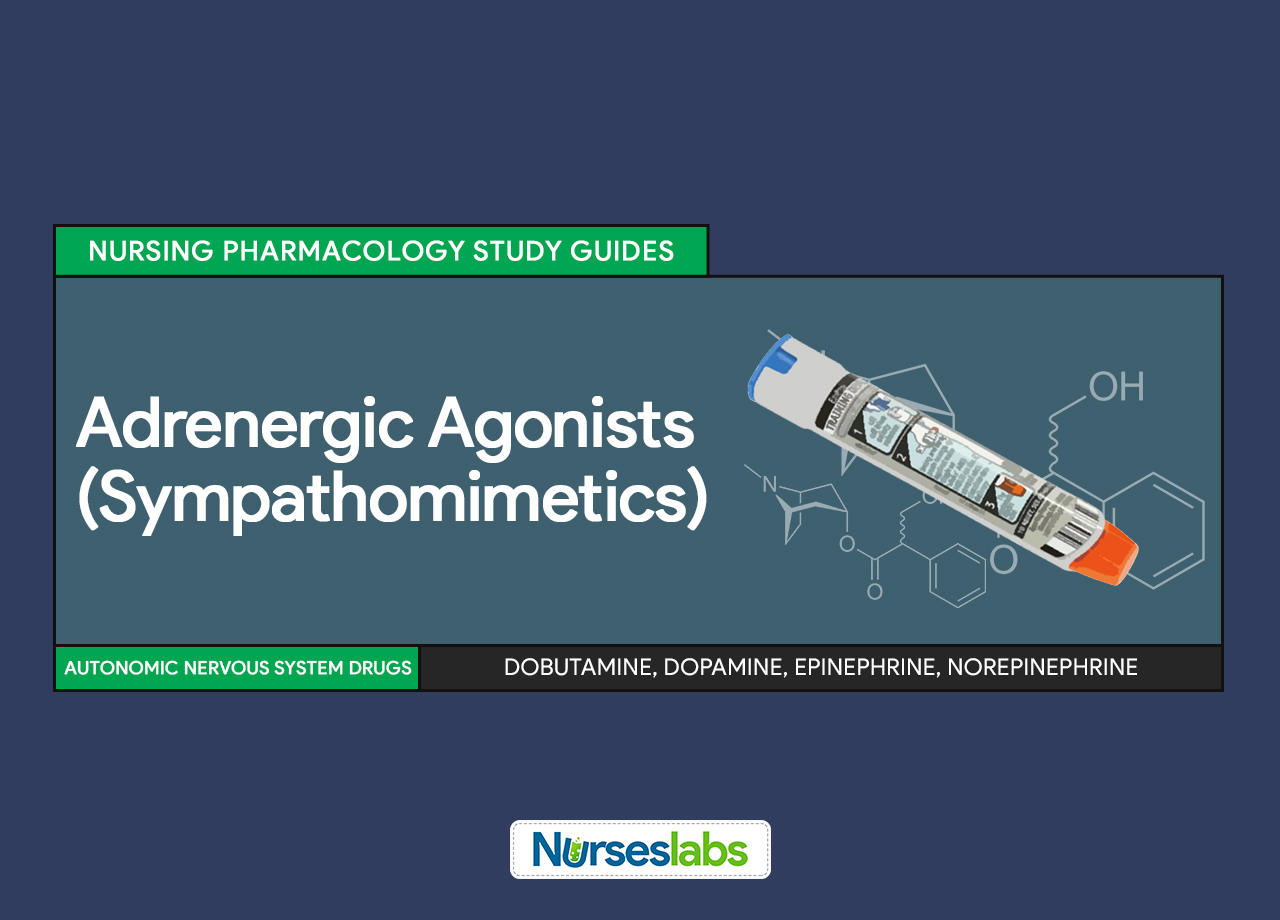

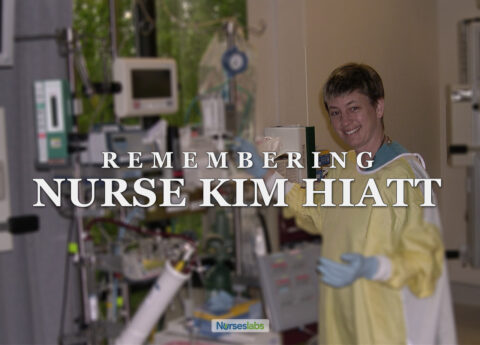
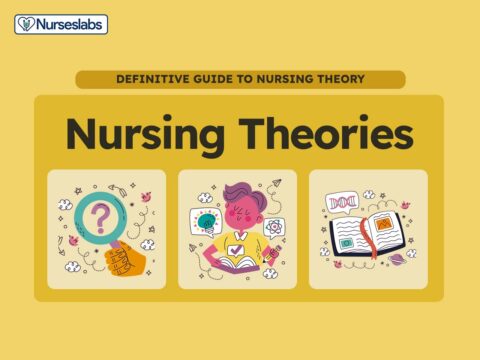


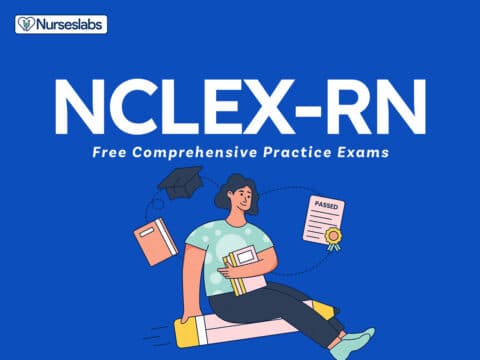
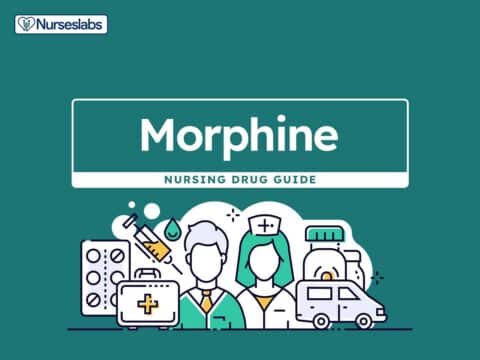
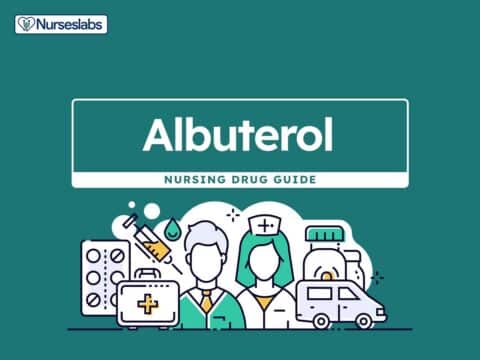
![Furosemide Nursing Considerations and Patient Teaching [Drug Guide]](https://nurseslabs.com/wp-content/uploads/2023/07/Furosemide-480x360.jpg)
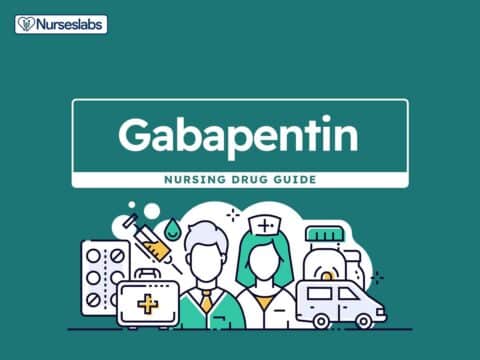
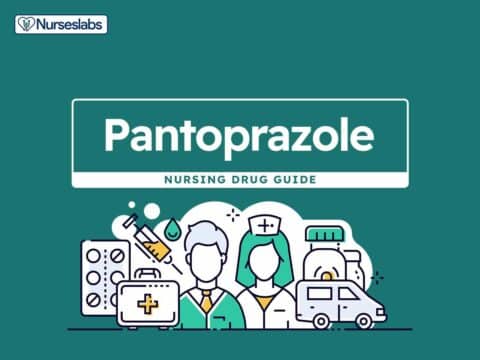
![Lisinopril Nursing Considerations and Patient Teaching [Drug Guide]](https://nurseslabs.com/wp-content/uploads/2023/03/Lisinopril-480x360.jpg)
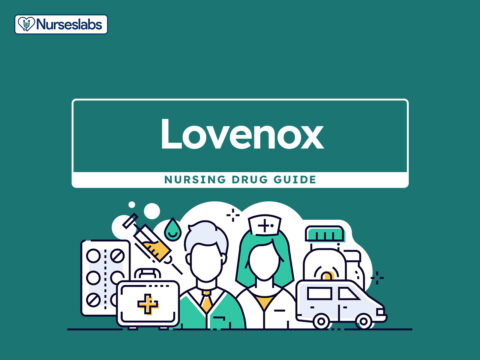
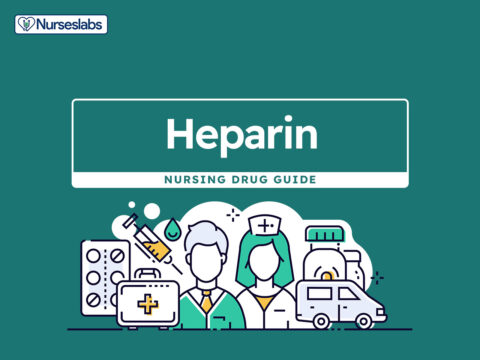
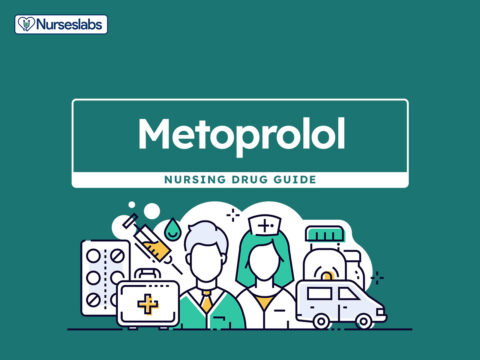
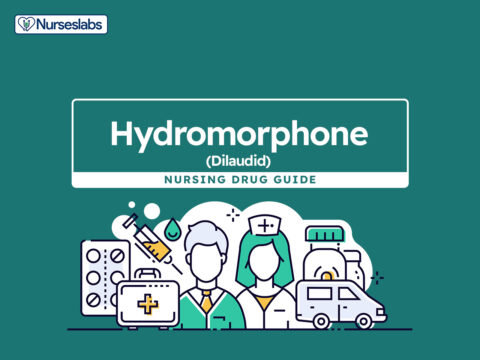
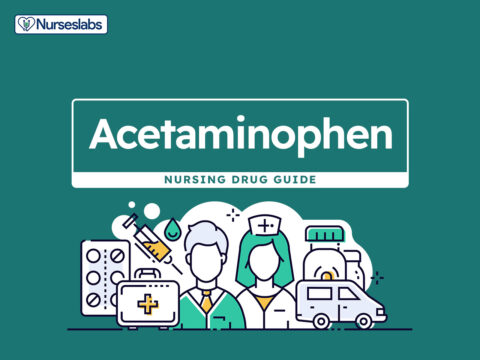

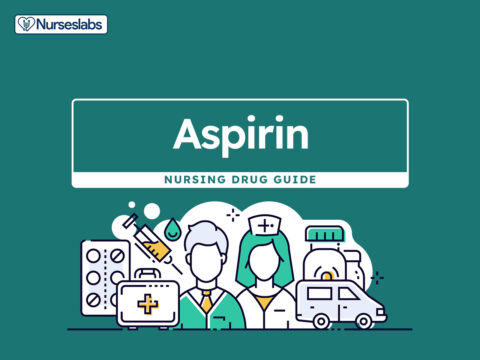
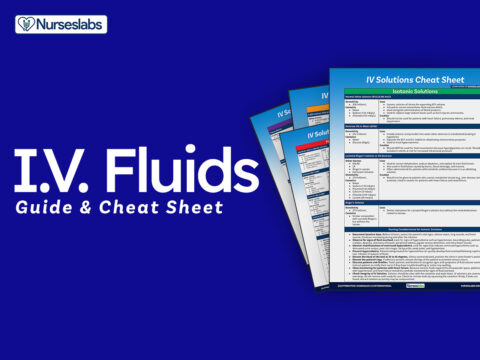
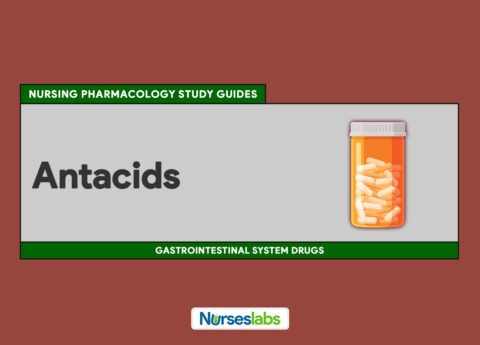
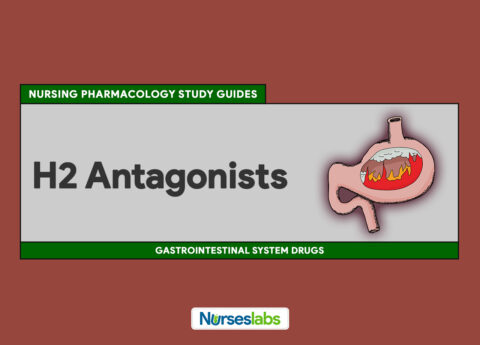
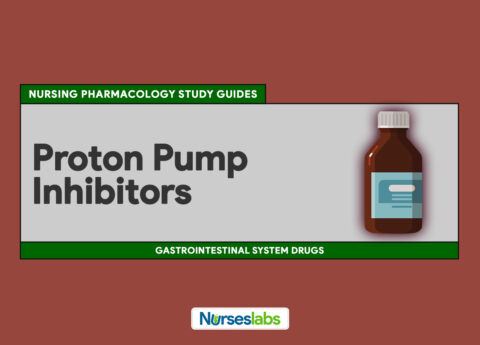
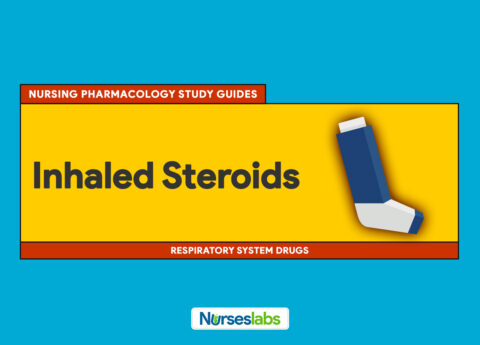
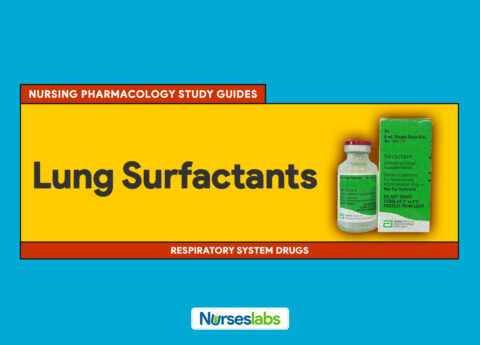
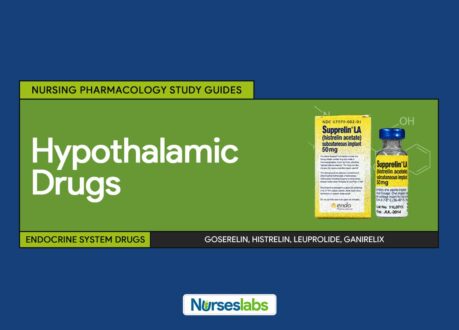
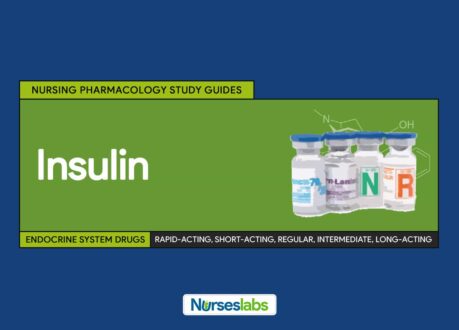
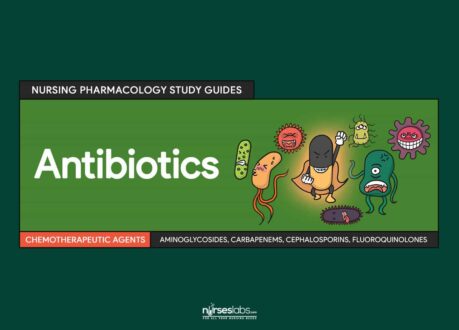
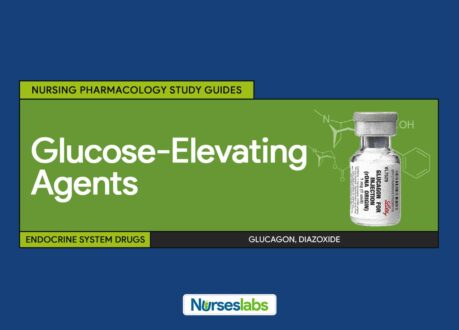


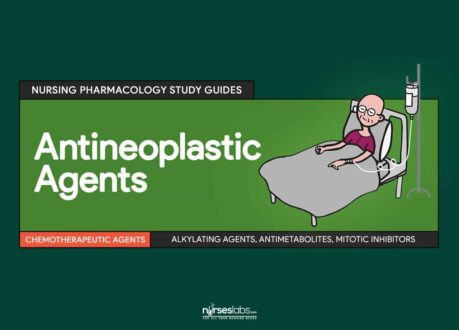
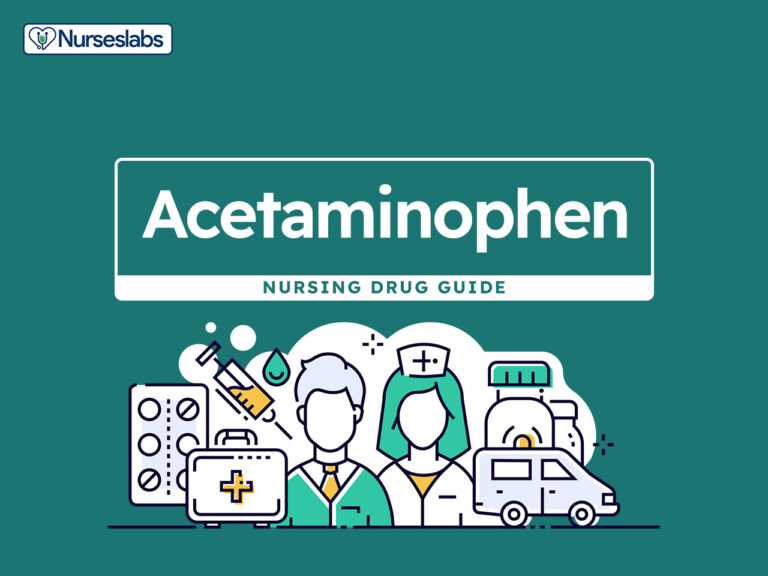
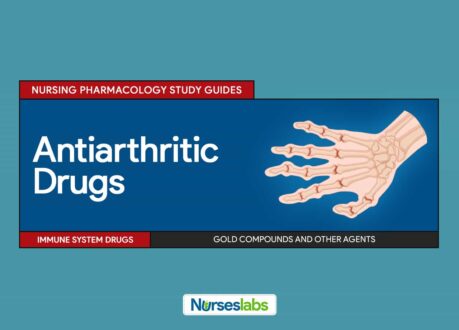
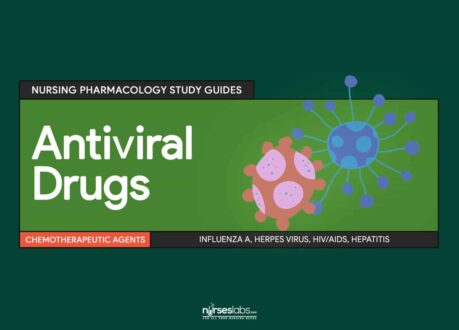
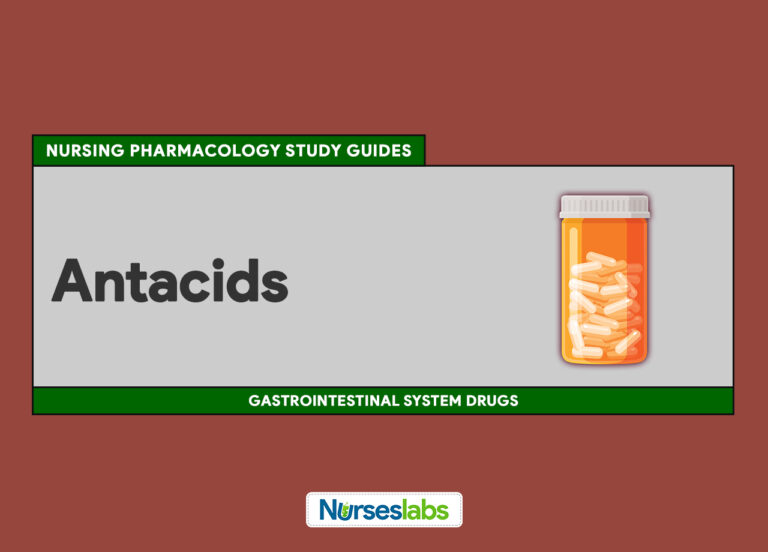

Leave a Comment